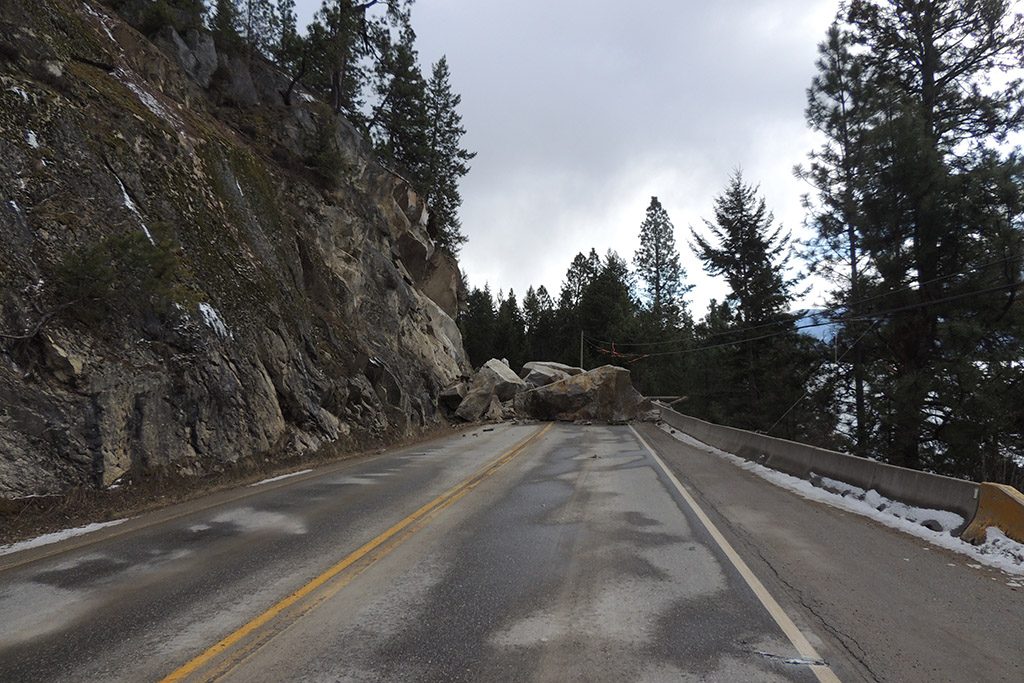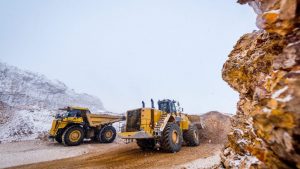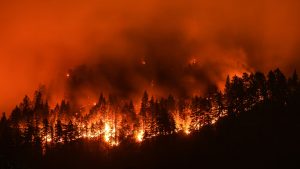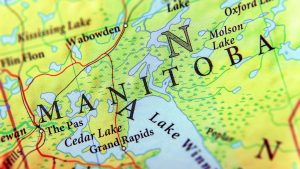Wherever rocks meet roads, the B.C. Ministry of Transportation and Infrastructure’s (TranBC) Rockwork Program is on the job, ensuring that rockfalls are quickly cleared from roadways, and that fragile rock formations will be safely removed or pinned to mountainsides to improve driver safety.
The RockWork Program is responsible for about 47,000 kilometres of roads, which encompass 21,000 slopes along major roadways. In any given year, the province experiences 1,600 rockfall events.
“March is our most active month for rockfalls,” says Mike Dowdle, a geotechnical engineer and manager of Rockwork Engineering with TranBC. “Slopes are thawing, freeze-thaw cycles are occurring and there’s a likelihood of good storms and precipitation that tend to trigger rockfalls.”
The Rockwork program’s three engineers and four technicians inspect slopes year-round.
“We do rockfall assessments where we assign a score for high-hazard slopes along our highway network,” he says.
“That includes factors such as the height of the slope, how effective the ditches below the slopes are, geological factors, the weather and climate in that area and the traffic volume. That allows us to prioritize which slopes present the greatest hazard to the traveling public and helps us to decide where we’ll do proactive work to stabilize slopes and reduce risk.”
One of the most common risk reduction measures is rock scaling in which experienced scalers rappel down the slopes and use pry bars to remove loose rocks. For more stubborn rocks that appear loose but won’t succumb to the pry bar, explosives can be used in trim blasting operations.
“If we see larger rocks where we can improve stability, we prefer to do that instead of increasing the risk of destabilizing more of the slope by blasting them,” says Dowdle.
“We drill a hole through the rocks and insert steel anchors to fix them to the more intact rock behind them. We use a hydraulic jack and tension the anchors to 31,000 lbs. to increase frictional resistance of the joints in the rock and then grout the anchors in place.”
Horizontal drains placed in slopes can also be used to reduce water pressure that may cause rockfalls. Other rock control measure include: installing slope mesh to direct small rocks into highway ditches; applying shotcrete to slopes to prevent rocks from loosening; and installing catch fences to intercept high-energy rockfalls.
Newer roads are designed with extra protection—deeper and wider ditches that tend to contain rockfalls.
Roads are regularly patrolled by maintenance contractors who clear them of rock and debris. They also log the location and size of rockfalls, information which TranBC enters into the rockfall database. Most rockfalls are minor, sprinkling roadways with fist-sized rock debris that can be easily cleared. Disaster-movie style rockfalls involving massive boulders are rarer.
“The likelihood of those types of rockfalls is on the lower end of the spectrum,” says Dowdle. “It’s just dramatic when it happens. If they block highways in populated areas, there’s a lot of pressure to resolve the situation.”
When the big boys hit the road — rockslides of between 1,000 and 10,000 cubic metres — it’s time to bring in the heavy artillery. Not usually dynamite, but “boulder busters.” These are metal tubes containing shotgun cartridges with all the pellets removed.
“They drill holes into the boulder, fill the holes with water, then activate the cartridges,” says Dowdle. “The shockwave breaks up the boulder.”
The slopes near large rockfalls are also assessed for further instability and cracking. If there’s more potential for rocks to fall, they can be scaled, trim blasted or pinned. Often, the team needs to coordinate with railways using the same corridors, or utilities who may have to temporarily move infrastructure such as power lines during the operation.
Dowdle has been in the rock business for 26 years, but likes the variety of work. Sure, it’s all rocks, but each situation is different and requires a solution engineered to match.
“Gravity never sleeps,” he says. “The B.C. mountains’ dream someday to become flat like Saskatchewan. Until they make their way down, we’ll be needed to keep rocks from roadways.”











Recent Comments